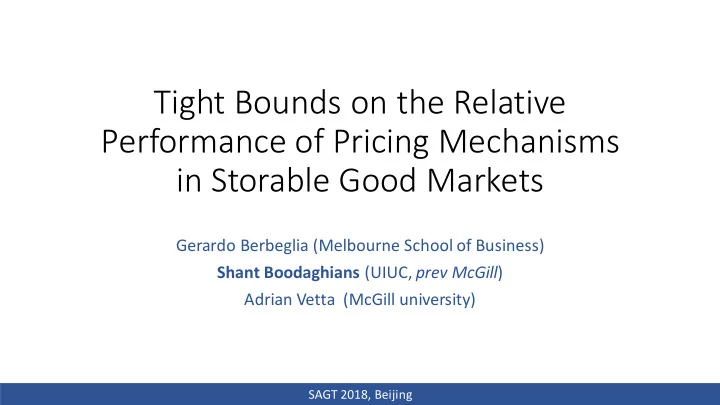

Tight Bounds on the Relative Performance of Pricing Mechanisms in Storable Good Markets Gerardo Berbeglia (Melbourne School of Business) Shant Boodaghians (UIUC, prev McGill ) Adrian Vetta (McGill university) SAGT 2018, Beijing
Storable Good Market • Selling over multiple time periods, agents have a demand at each time. • Goods are storable at a cost: If a good gives value v at time t , and is bought at time s < t for price p , then the buyer gets value v ‒ p ‒ c · ( t ‒ s ) , paying price and storage cost. • Restaurant example: Restaurant sells a yogurt dip. Price of yogurt changes every day, but expensive to store. When to buy? Buy early and store? SAGT 2018, Beijing Berbeglia, Boodaghians, Vetta
Storable Goods Mo Monopolis list • Wants to maximize revenue. Two pricing models: Π PA • Pre-Announced Pricing (Commiting ahead of time) Π CP • Contingent Pricing (No-Commitment / Threat / Subgame Perfect) • Computing optimal prices are very different optimization problems! Question : Which Strategy gives more revenue? • Economic Effects at Play: • Consumption Effect: Raising prices means fewer purchases • Stockpiling Effect: Raising prices causes more storage, and earlier purchase Storage is lost revenue , because they were willing to pay SAGT 2018, Beijing Berbeglia, Boodaghians, Vetta
Example for Commit > Threat t = 1 t = 2 Consumer Suppose storage cost c = 1 v = 1 Alice No demand and consider demand as follows: v = 2 Bob No demand • Contingent Pricing: Π CP = 2 It is optimal to set p 2 = 2 , since subgame perfect. If p 1 > 1 , Alice doesn’t buy and Bob waits, so Rev = 2 If p 1 ≤ 1 , Alice buys, and Bob buys early and stores, so Rev = 2 p 1 . • Pre-Announced Pricing: Π PA = 2.999 Set p 1 = 1 , p 2 = 1.999 . Alice buys, Bob benefits from waiting instead of storing. SAGT 2018, Beijing Berbeglia, Boodaghians, Vetta
Example for Threat > Commit t = 1 t = 2 Consumer Suppose storage cost c = 1 v = 6 v = 6 Alice and consider demand as follows: v = 4 v = 2 Bob • Pre-Announced Pricing: Π PA = 12 Set p 1 = 4 , p 2 = 2 , everyone buys. Or p 1 = 6 , p 2 = 6 , Alice buys. • Contingent Pricing: Π CP = 14 If Alice doesn’t buy early and store, monopolist sets p 2 = 6 ! So set p 1 = 4 , Alice buys 2 units, and Bob buys 1, Then can set p 2 = 2 which gives Rev = 14 . SAGT 2018, Beijing Berbeglia, Boodaghians, Vetta
Results • Deciding which pricing strategy to use is not straightforward! • This paper: Let N buyers and T time steps, then at any subgame-perfect equilibria, Π PA ≤ Π CP · O ( log N + log T ) , and this bound is tight • Past work [Berbeglia, Rayaprolu, Vetta]: For any SPNE, Π CP ≤ Π PA · O ( log N + log T ) , and this bound is tight • Coase conjecture (1972): Commitment always better than contingent. • Proved true in infinite horizon , not true in general. [Gul et al., 1986] SAGT 2018, Beijing Berbeglia, Boodaghians, Vetta
Proof of Upper Bound : Π PA ≤ Π CP · O (log N + log T ) • Introduce fixed price: commiting to a single price at all times. “ Π F ” • Clearly, Π F ≤ Π PA , but, Π PA ≤ Σ v i ≤ Π F · O (log N + log T ) , • If v * is i -th best value, then j -th best value is at most ( i / j ) v* • So Σ v i ≤ v * Σ ( i / j ) ≤ Π F · ln ( NT ) • Want to show Π F ≤ Π CP , Prove by showing that charging the optimal fixed price is suboptimal in the contingent setting, but sells at least as much as Π F . SAGT 2018, Beijing Berbeglia, Boodaghians, Vetta
Tight Example • Idea: n consumers, each demanding at different times, • Consumer i has value 1/ i for one unit, lower indices consume earlier • Storage cost ≈ 1/ n 3 • Consumption times are spaced out just right so that, no one stores if p i = 1/ i – ( n – i + 1 ) / n 3 1 1 / 2 1 / 3 1 / 5 1 / 4 SAGT 2018, Beijing Berbeglia, Boodaghians, Vetta
Tight Example • No storage if p i = 1/ i – O ( 1/ n 2 ) but storage is better if p i = 1/ i • Total commitment revenue is ≈ log ( n ) – 1/ n • everyone buys at almost their total value • However, contingent pricing equilibrium sells all-or-nothing at any time! So if you sell at time i , you get i · 1/ i = 1 in total, and the game ends • Seller’s strategy is to charge price 1/ i when buyer i has value Buyer’s strategy is to only buy if someone has value, and price is good enough • Seller cannot improve: charging less loses revenue and everyone still buys, charging more leaves some revenue on the table that will disappear in the next round. - Buyer cannot improve since buying earlier means more savings SAGT 2018, Beijing Berbeglia, Boodaghians, Vetta
Thank you SAGT 2018, Beijing Berbeglia, Boodaghians, Vetta
Recommend
More recommend